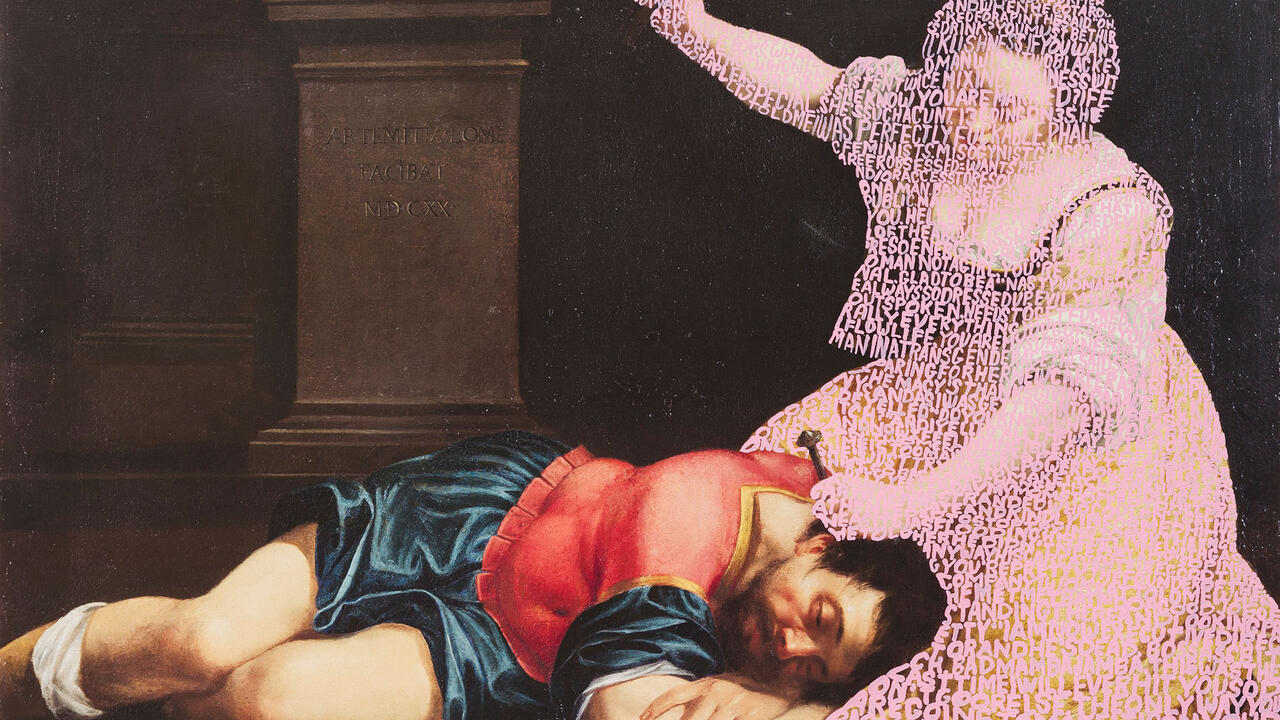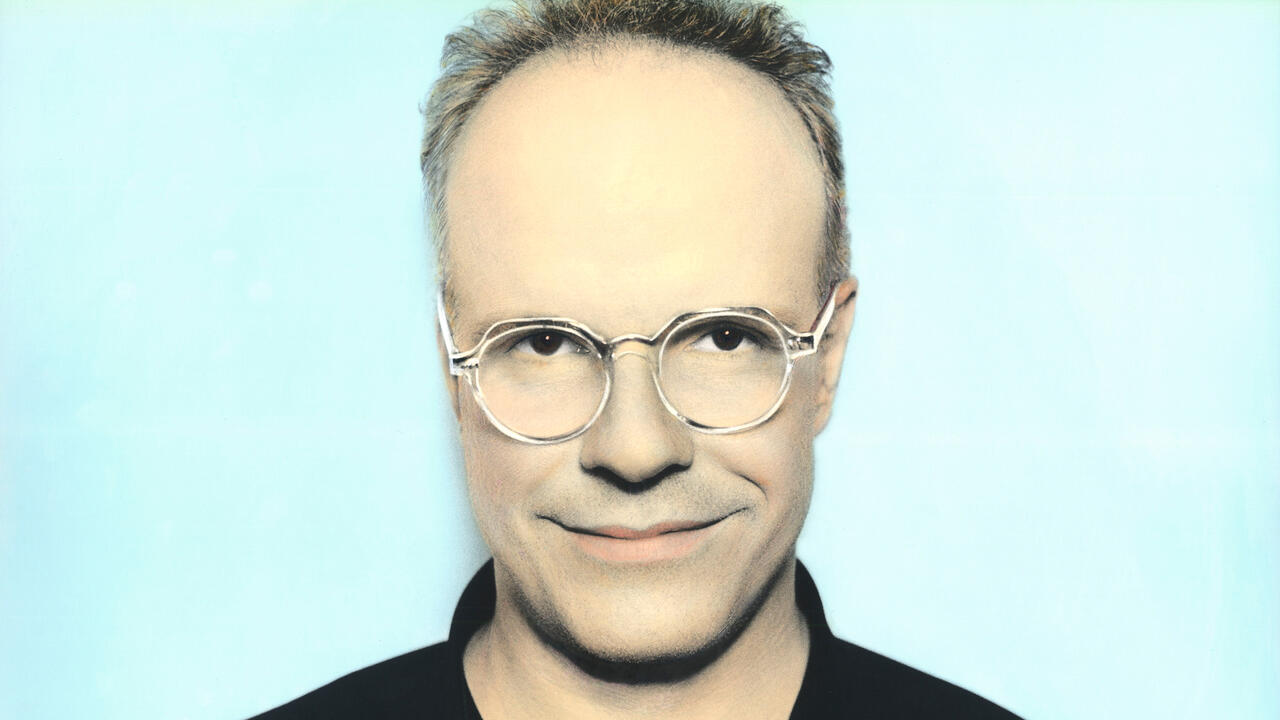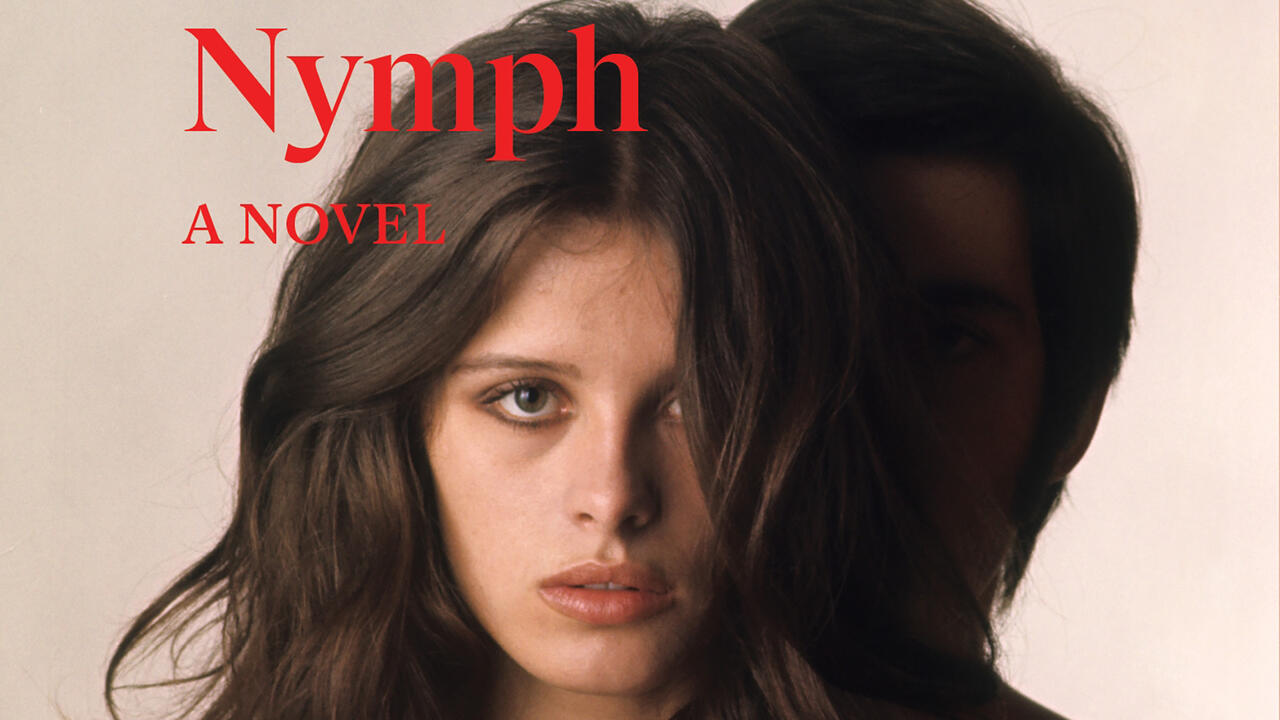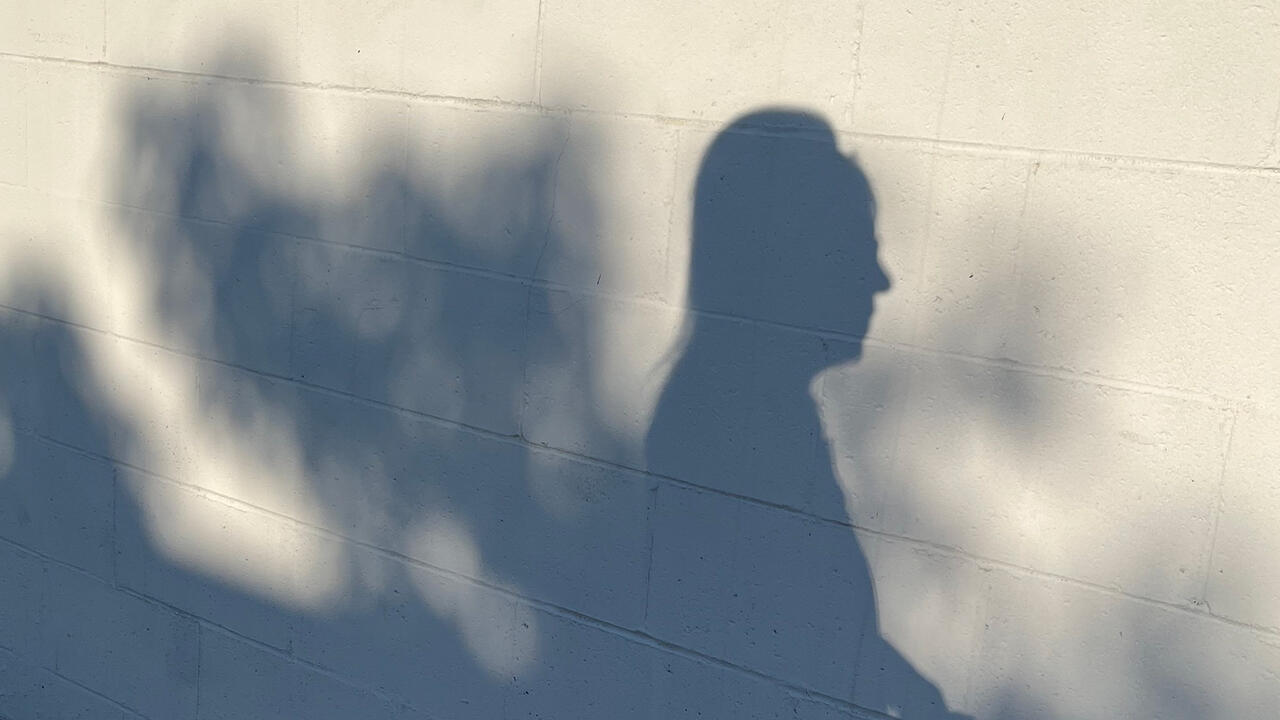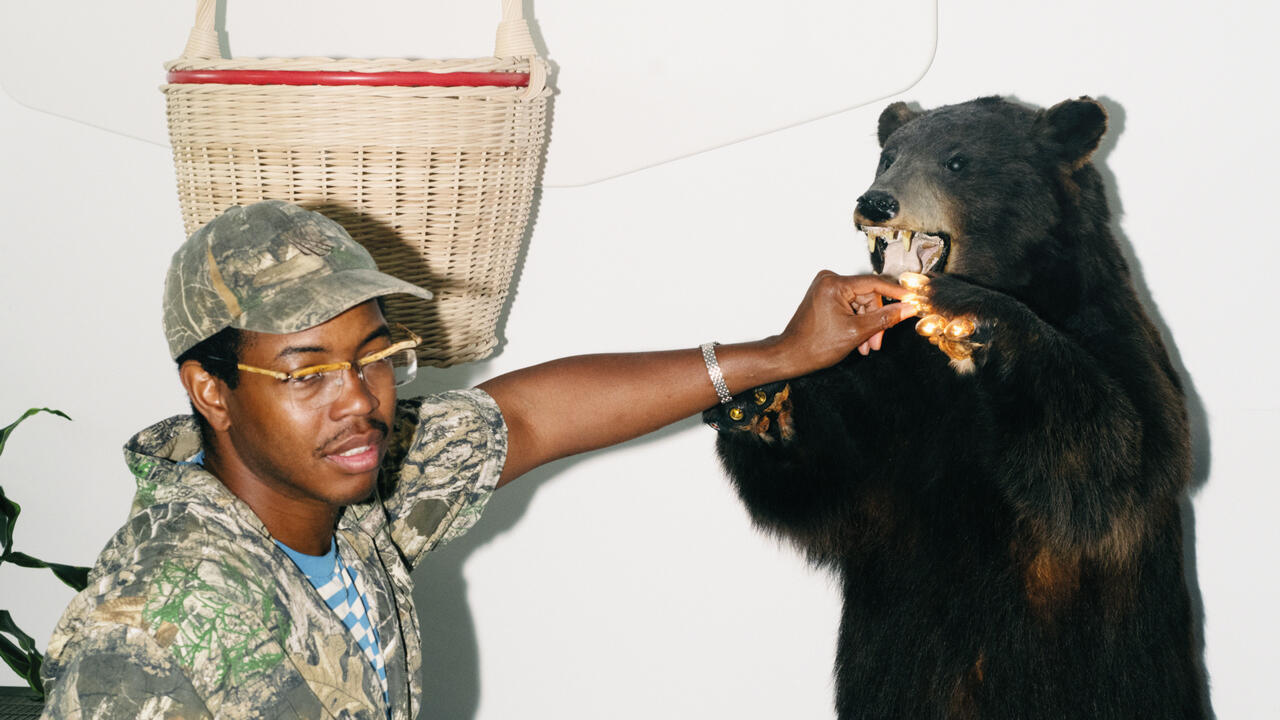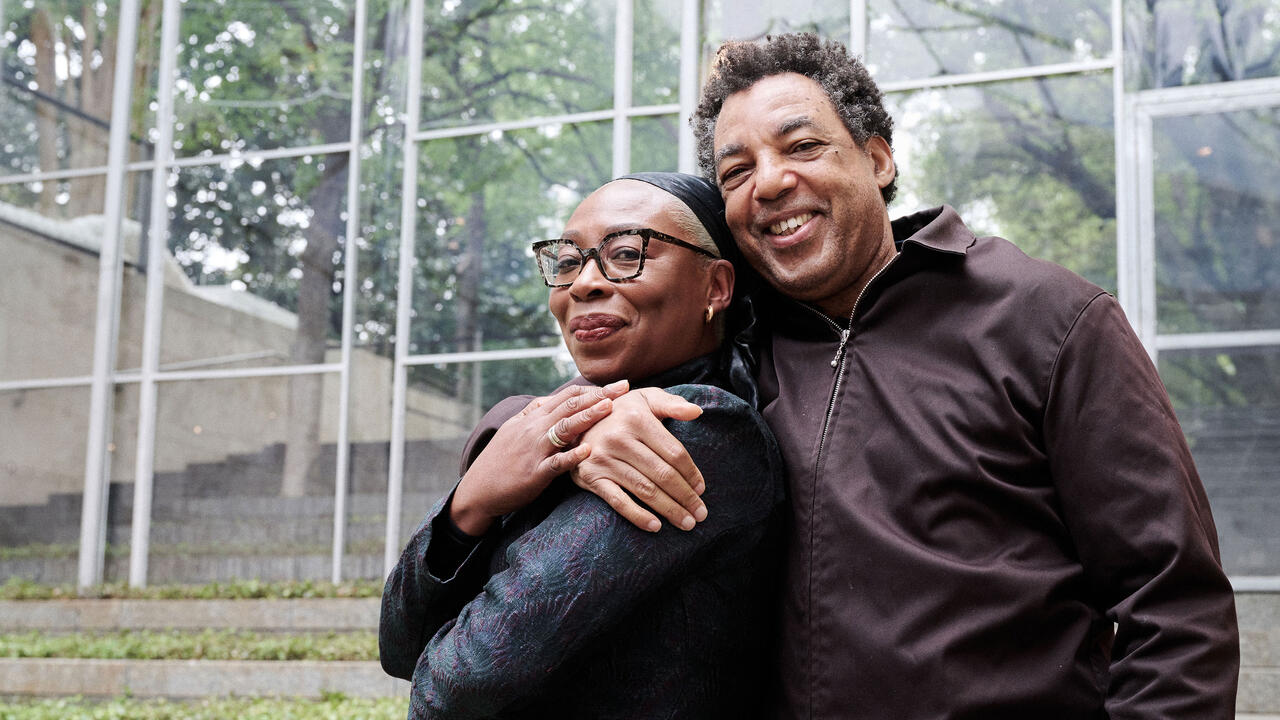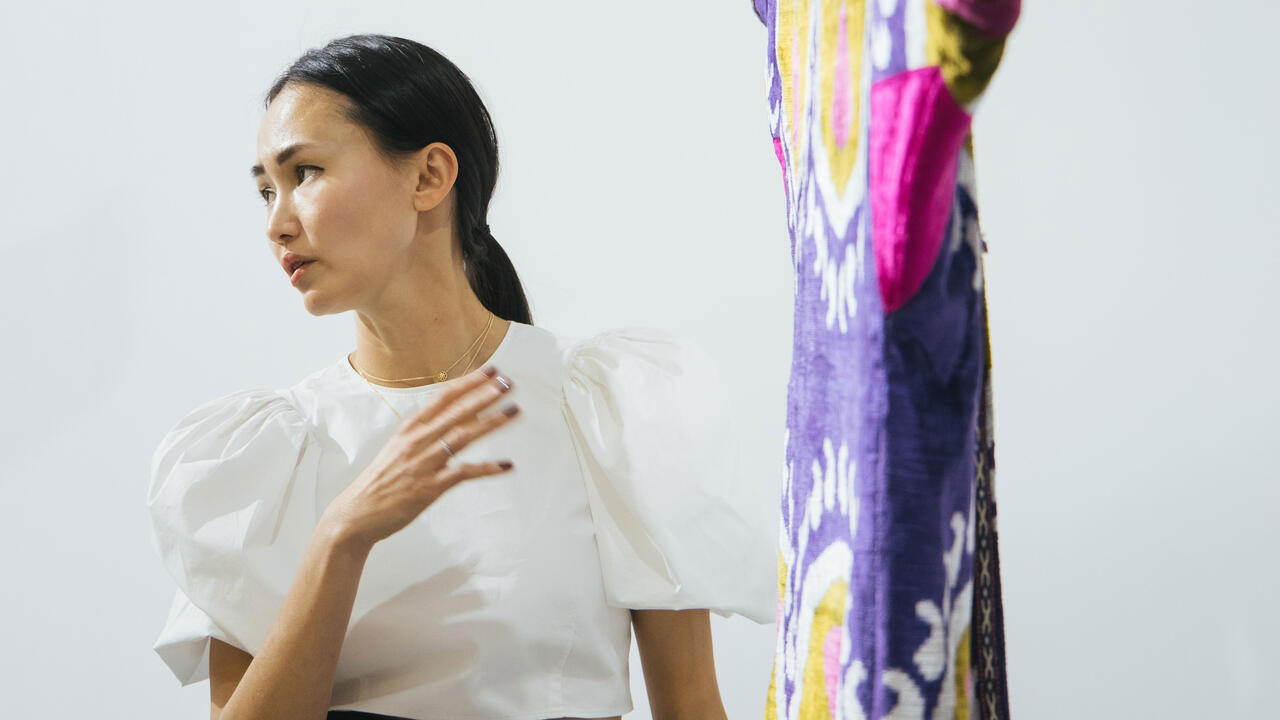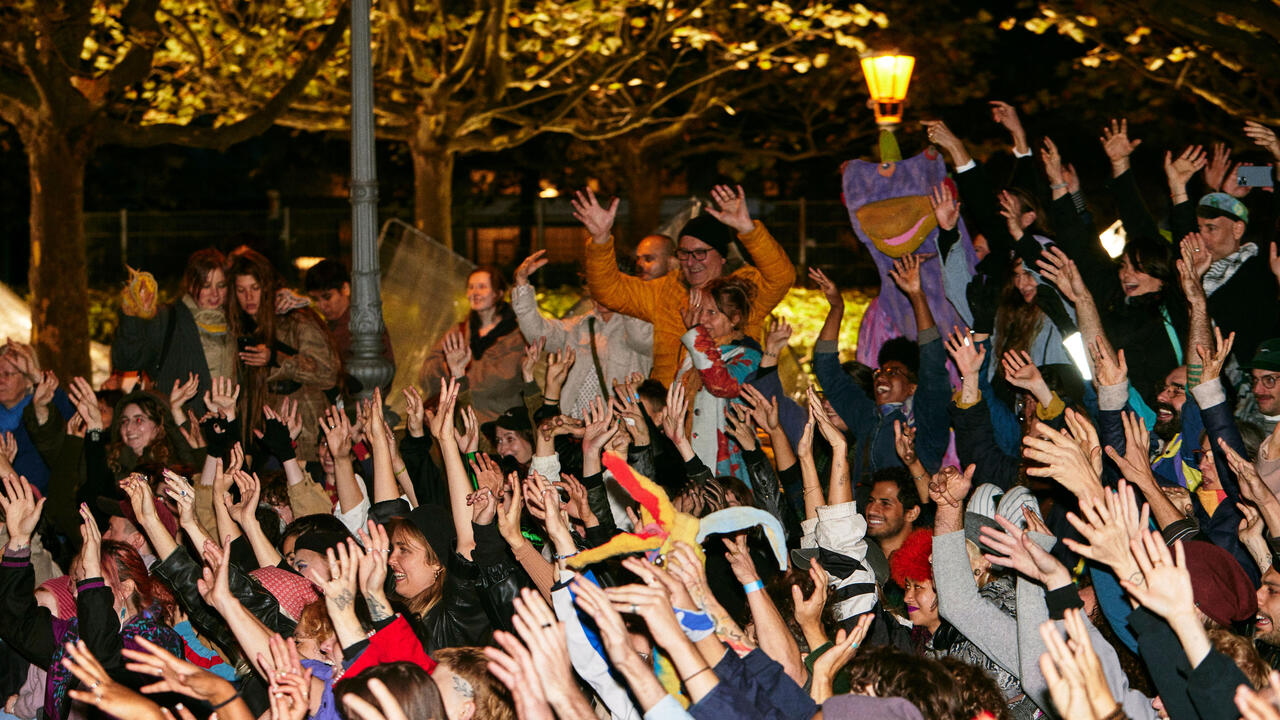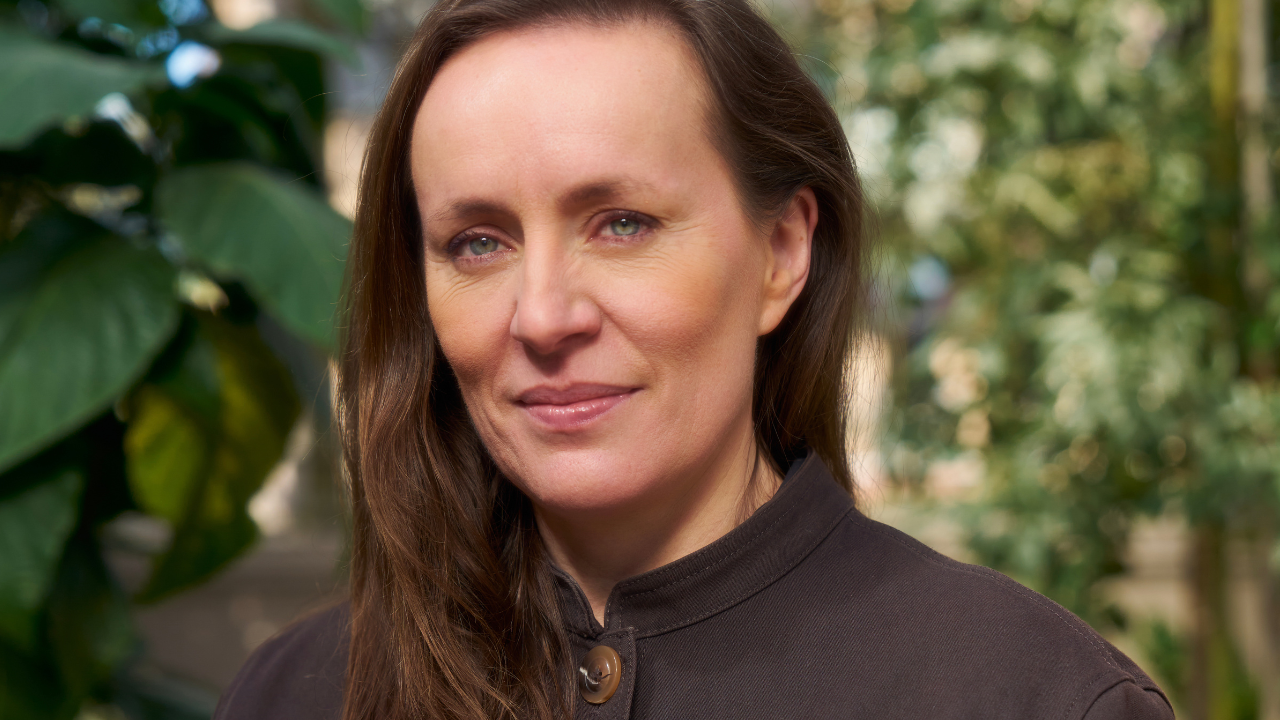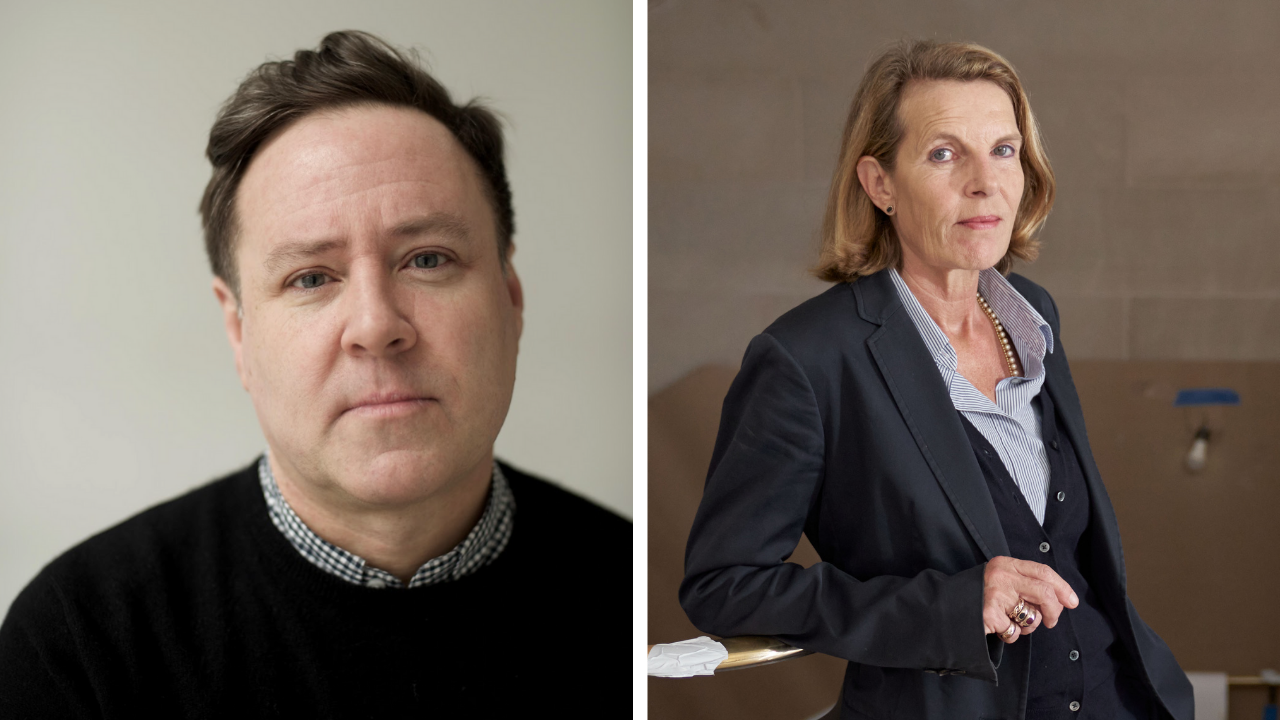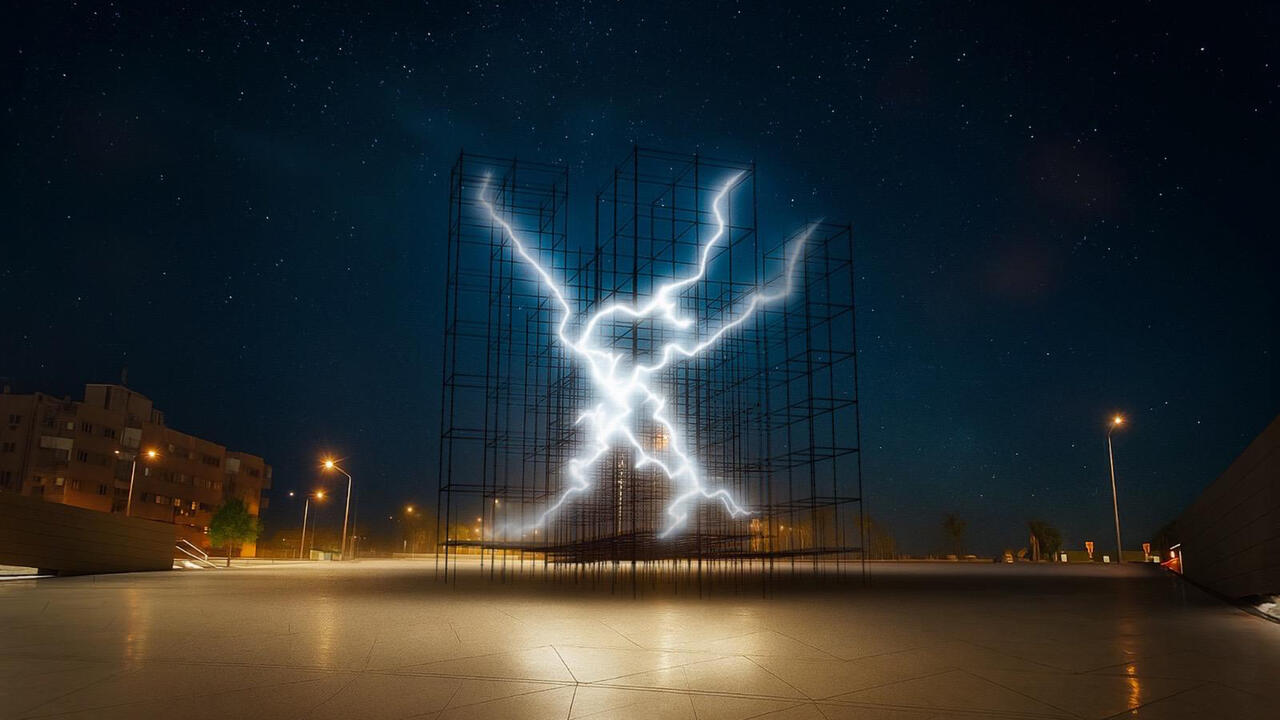Inside Out
Maria Lassnig in conversation with frieze co-editor Jörg Heiser
Maria Lassnig in conversation with frieze co-editor Jörg Heiser

Jörg Heiser: Your works of the past two or three years are all painted on a uniformly primed canvas on which bodies are portrayed without a background.
Maria Lassnig: That is a return to something similar to my ‘Static Meditations’ from the 1950s: simple brushstrokes on a naked, primed canvas. Background creates mood and atmosphere, and I don’t need that.
JH: Du oder Ich (You or Me, 2005) – which shows you naked, pointing a gun at your head and another gun at the viewer – is a really drastic, brutally direct picture with a certain theatricality.
ML: I call these works ‘genre’ paintings.
JH: Why ‘genre’?
ML: ‘Genre’ is actually more derogatory; ‘drastic’ is better. I mean, something happens; a story. Portraying one person is rarely enough to tell a story. But when there are two people in a picture, that is already a story. One cannot help attributing meaning to their relationship.
JH: In the case of Drei Arten zu sein (Three Ways of Being, 2004), the title suggests that it is the same person, i.e., the artist herself.
ML: Yes, yes: me, myself and I.
JH: The process of introspective body awareness, from which most of your pictures result, is fanned out here in exemplary form. To the point of the grotesque red pig’s nose on the middle figure of the three.
ML: The sense of colour, right? Red anger. Although I didn’t necessarily intend it that way. The fewer intentions I bring to a picture, the better it usually turns out.
JH: And how does one prevent intentions?
ML: If I want to paint something very specific, then that is an intention. But I approach my work without intentions. The only intention is that I sense the way I am standing in front of the canvas at that particular moment. And then I go into detail. And, of course, I have to give form to that – because a feeling has no form; it is a dissemination. I had to discover the ‘pure’ colours for myself, because I went to the academy in Vienna during the Nazi period, a diligent student. When I painted my first self-portrait, the professor said: ‘You paint like Rembrandt’. That was flattering, of course. But the colours were shades of brown, as few pure colours as possible.
JH: Earthy colours.
ML: In any case, even then I was beginning to break things down. For another self-portrait I tried to fix a point – what kind of colour is that: I mean, flesh colour? I realized I had to decide on a colour, that it was my decision what colour I use. And then I moved on to the next point, which of course has a slightly different colour, in the shadow, the shaded tone and so on.
JH: In spite of the Nazis, did you have access to information about Expressionism etc.?
ML: No. The books were removed from the libraries. And after the war it was intoxicating for me, seeing all that for the first time.
JH: Are your recent ‘genre pictures’ or ‘drastic pictures’ a temporary turning away from the introspective body awareness approach, and, as such, also a form of reminiscence about this early period?
ML: That was a big jump for me, from the interior view to the retina view and the horrors of the outside worldview. Even back then, during my American ‘realism’ period in the early 1970s.
JH: These pictures are drastic in the sense of a narrative reduction.
ML: Yes, they really knock the truth on the head with a hammer. That’s what makes them drastic.
JH: Is that an important distinction for you? On the one hand, gentle, searching pictures that come out of a more diffuse state, and on the other, pictures that assail you with brute force?
ML: It may have to do with the fact that when I moved to New York in 1968, I arrived with the body awareness paintings – the Americans didn’t understand those at all.
JH: The same thing happened to Philip Guston. When he showed his new figurative paintings in the autumn of 1970, after decades of being known as an Abstract Expressionist, he was fiercely attacked, cut dead.
ML: Yes, I read about that too. But I never met him, and I never saw him there.
JH: Maybe this parallel is one reason why someone like Robert Storr, for whom looking at Guston’s work was a formative experience, responds so strongly to your work.
ML: But Guston was a different type, and he was already established. They wouldn’t even show my work, said it was trash. And my upstairs neighbour in the loft said to me: you just can’t paint. That was when I painted these pictures – American realism. Green light without colours. How terrible. [laughs]. That they understood.
JH: Are you saying that you gave in?
ML: No, I actually did begin to enjoy it. It wasn’t so simple. I hadn’t painted a nude since my time at the academy, and the light in my studio was not good. It was hard. No colours. I didn’t see any.
JH: From today’s perspective this is hard to understand: why ‘realistic painting’ was more readily accepted in the 1970s than a grotesque, distorted or let’s say somehow non-realistic figurative picture.
ML: No, at the time distortion was considered pathological. Pathological. But that is sometimes still the case today. I was recently panned by critics on German television. Bazon Brock and Jean-Christoph Ammann said in so many words that what I do is just caricature. Then a female critic came to my defence.
JH: These are people who would never dream of referring to the distorted, grotesque portrayals in Francis Bacon’s work as caricatures. Which is not to say that they are, in either case. Were you interested in Bacon at the time?
ML: Of course. Yes. People were always comparing me with him, and that made me livid.
JH: Why? Is there not a related interest in physical self-awareness? Although Bacon often placed the bodies very clearly in an architectural space.
ML: That’s the background again, which doesn’t interest me. And Bacon painted it so beautifully. Like a good boy. So diligent. Making little glass boxes. That annoyed me too.
JH: But you did look at what he was doing.
ML: Of course. I also saw that he is a genius. I really would have taken off my hat to him if I had met him. But he was not a kindred spirit, because of his painting from photographs; I only painted from my imagination. But he was certainly an emperor, a king.
JH: You’re right, of course. It makes a big difference. How one is perceived: acknowledged or not acknowledged. In the 1950s you had to assume that, as a woman, and especially as a woman from provincial Austria, you would not be at the centre of things.
ML: At the time there was the Galerie nächst St Stephan in Vienna, which was run by a cleric, Monsignore Mauer. In 1956 he featured me in a show with four men. And when he saw my new pictures for the first time, he said, ‘Ha ha, so that’s supposed to be you!’ He made terrible fun of me. And so I chose a term: introspective experiences. At the time I was painting these dumplings of colour, proper circles or ovals, or lines as outlines of the bodies.
JH: Where did the word ‘dumpling’ come from? Was that partly a humorous way of dealing with it?
ML: No. A dumpling is a dumpling. A round object.
JH: There is a journal entry from 1980 where you give a precise description of the process of introspective body awareness that gives rise to your pictures. I quote: ‘Paint a picture in a particular body position, for example sitting down. Resting on one arm, one feels the shoulder blade, of the arm itself only the upper part, the palms of the hands like the grips on a crutch …’
ML: Yes, I was always using comparisons. Which is no good, is it?
JH: But surely the comparisons with prostheses are no coincidence? Marshall McLuhan developed the notion that a wristwatch or a screen in front of the eyes is an extension of the body – of the sensory organs and one’s entire apparatus, so to speak. But let me read you some more: ‘I feel the points where my backside presses into the divan, my stomach because it is filled like a sack, my head is sunken into the cardboard box of the shoulder blades, the skull is open at the back, in my face I feel the nasal opening, as big as a pig’s, and around it I feel the skin burning. I’ll paint it red.’ Here the metaphor begins to change …
ML: I’m talking about an animal there – but these comparisons are a weakness of mine.
JH: Yes, but there is this gravitational heaviness. Almost as if feeling like a sack of potatoes or something …
ML: I made a picture of that, Der Kartoffelsack (The Potato Sack, undated).
JH: In Modernism this theme, the sheer embarrassing presence of the body, is stronger still in sculpture. And there is the saying – sometimes attributed to Baudelaire, sometimes to Barnett Newman – that sculpture is what you trip over when you step back to look at a painting. This expresses the idea that painting ultimately does away with the body, overcomes the embarrassing presence of the body.
ML: That’s right. But what appealed to me was precisely this difficulty. It is more or less the most difficult subject to paint. Something you don’t actually see.
JH: This is also the interesting thing about your strict rejection of involving photography in painting because you say: I want to paint precisely that which cannot be captured by photography.
ML: The camera does almost all of the work, no? You press a button, and half of the picture is already there.
JH: One might see that as an advantage, that photography relieves you of unnecessary work?
ML: But what you’re calling unnecessary work is the most important part for me. I have always been troubled by the way the early photographers, Eugène Atget for example, felt like gods. Really like gods. Someone comes along with a machine and thinks he’s a god and wipes out painting – it’s not necessary.
JH: But 19th-century photography was also interested in making the invisible visible. There were loads of ghost and aura photographers. And X-ray photography showed the bones. But, of course, that is an entirely different way of looking.
ML: I’m not comfortable with a parallel like that.
JH: Why?
ML: Not comfortable at all. If someone looks very similar to me, then I find it embarrassing.
JH: You mean in relation to a type of photography that somehow bears a resemblance to your work?
ML: Yes, yes, it’s embarrassing. There is a similarity, but a deceptive one. It has a blurred quality. I don’t like blurred things at all. Photographs can also very easily be blurred …
JH: I understand ... But I was talking about a different kind of embarrassment: the earthy heaviness, the embarrassing presence of the body. It’s a feeling familiar to all kinds of social situations; a certain sense of unease in one’s physical presence, perhaps a fear that one might do something that gets out of hand. These are things or states that play a part in your pictures, aren’t they? Which would mean they take an offensive approach to what is embarrassing.
ML: No. At least, not when I paint. When I’m painting, almost everything is allowed. Embarrassment is a challenge; I want to paint things that are uncomfortable.
JH: How did you arrive at this freedom? Around 1950 you were making Surrealist drawings, and there is also a Sex-Selbstporträt (Sex Self-portrait) from 1949.
ML: In Klagenfurt, where I lived at the time, there was a judge who wrote Surrealist poems. And so Surrealism came to our small town.
JH: That’s a nice sentence: ‘And so Surrealism came to our small town.’ In this respect, too, there was some catching up to do after the Nazi period. But in all the bodies, especially the male ones, and not only in Germany and Austria, there was still the experience of fighting the war. Is this what comes out in the less accomplished moments of Tachisme as a kind of flailing about in front of the canvas, as gestural displacement activity resulting from numbed physicality?
ML: There was a tendency to understand the body strictly from the outside. Even in Cubism, which divides people up. Thank God, Surrealism was still going when I was in Paris in 1951, where I got to meet André Breton, although he counted anything that bore even the remotest resemblance as part of Surrealism. Benjamin Péret wrote a text for my portfolio of drawings Garten der Leidenschaften (Garden of Desires, 1950).
JH: So the theme of the body came partly from Surrealism?
ML: Well, it was a liberation from tradition. Quite simply.
JH: There is the picture Kinderwagenform (Pram Shape) from 1951–52. In this context the title sounds ironic. A reference to the traditional role of women. Was it ironic?
ML: Probably, yes, but that’s too complicated.
JH: But at the time the controlled painting procedure of the ‘Static Meditations’ was also a deliberate decision against the expressive, against explosive flailing about …
ML: Yes, it was the time of Georges Mathieu. But he was very, very short-lived. Yves Klein made a far stronger impression on me with the way he printed models onto the canvas with paint. But I never imitated it. At a group show in Paris in 1962 Klein came in, stopped in front of my picture and asked who had painted it – and I stood in the background and was very proud, because he was a celebrity, and I was not a celebrity.
JH: But surely there’s a difference between your approach and the female body as a fetish in Surrealism or as an instrument to paint with in Klein’s ‘Anthropométries’ (1960–61)? Did you ask yourself: how can I relate to this as a woman, as a woman painter?
ML: I couldn’t have cared less. I had other problems. In Carinthia, where I came from, and where I was celebrated as a minor provincial star, when people saw what I was doing now, they threw up their hands and said: ‘For God’s sake, what’s happened to Lassnig? She is destroying all her talent.’
JH: How were you destroying it?
ML: By not painting people any more, but only dumplings and clumps of colour, and then calling them ‘self-portraits’.
JH: Knödelfiguration (Dumpling Configuration) from 1951, for example. You first received praise for managing to find an elegant form. Whereas in and of itself, painting dumplings is far from elegant. You worked with that which doesn’t fit, which cannot be subsumed within a smart, harmonious form. Would that be a fair way of putting it?
ML: No, I simply had to look for a form. All the indentations, the things one senses. Although even today, I still don’t wholly know why I then take the one thing and erase the other. It eludes me. Other people think these are fantasies. For me, they’re realities. Realities that I feel. And that really is a secret. For me it still is. My own secret.
JH: Is the secret not also how one recognizes this reality for oneself? In other words, to what extent am I imagining something? To what extent is it actually present?
ML: Yes, certainly. But the imagination itself is a reality.
JH: Do you not experience an effect whereby the next picture calls for new physical sensations? In the 1980s Jim Shaw began recording his dreams, making drawings every morning based on what he had dreamt, which had the effect of provoking dreams that grew wilder and wilder: the dream fulfils the wish for new pictures. Is your body awareness not influenced in a similar way on account of being such a central part of your work?
ML: No. I never paint dreams. And if I feel ill, for instance, it’s no good, I can’t paint that.
JH: That’s something else I’ve been asking myself: doesn’t this strong focus on one’s own body turn one into a hypochondriac?
ML: Thankfully, I possess a strong sense of reason.
JH: Which tells you when to stop?
ML: Yes, I mean, I’m a totally normal human being. Just very, very sensitive. So maybe I’m not so normal. But I am a rational being.
JH: In the 1940s you were already talking about introspection. At the time this notion was familiar from psychoanalysis, but also from religious, pietistic soul-searching. Yet you consult not the soul but the body. Which is the opposite of meditation as a spiritual transcending of the body. In your case one hears the blood rushing and the lymph nodes gurgling.
ML: No, not that. That’s going too far …
JH: OK, I’m exaggerating. Maurice Merleau-Ponty wrote about what happens when the right hand touches the left. What am I actually perceiving in such a case? Do I perceive myself primarily as exterior or as interior?
ML: I haven’t read Merleau-Ponty. But I have read Ernst Mach, although not until I got to America. But then I said: Mach, he’s the philosopher for me.
JH: There is the famous drawing Mach used in 1886 to preface his Beiträge zur Analyse der Empfindungen (Contributions to the Analysis of the Sensations), where we see the view from his left eye as he lies on a chaise longue, the view out over his moustache.
ML: We see what he sees, but he was not able to draw what is on the inside.
JH: Your drawing Die Verankerung (Anchorage, 1972) is slightly reminiscent of this, but with the addition of this handle that winds the body up like the key on a tin of sardines.
ML: Yes, I did a lot of drawing at that time, because one can lie on one’s back on the couch with the pad on one’s stomach ... like Mach.
JH: In 1968, when you went to New York, you painted Selbstporträt als Astronautin (Self-portrait as an Astronaut): this links the notion of the body within to the prosthetic quality of the space suit …
ML: In the body awareness pictures, however hard one concentrates on them, there is of course an outside world that exerts an influence. On the back, for example, there is the memory of the curve of a rucksack. Inner and outer worlds cannot always be kept apart.
JH: In principle there is always a difference between the way people think they look and the way they actually look. Even when they’re standing in front of a mirror. The extreme example is what is known in medicine as body dysmorphic disorder – a distorted perception of the body, as in the case of anorexia, or when someone is obsessed with the belief that their nose is too big or their chin too small.
ML: Yes, but that is a view that covers the body as a whole. My view is not holistic. If I don’t feel my feet, then I don’t paint them.
JH: The absurd dimension that results from the way we experience our bodies. Is that the humoristic side?
ML: That’s not the intention. No.
JH: No? No humour?
ML: No.
JH: More in the case of the drastic pictures, then?
ML: The way it comes out in the drastic pictures is more amusing.
JH: When you were in New York, in the late 1960s and early 1970s, Performance was playing an increasingly important role, artists like Yvonne Rainer and Vito Acconci.
ML: Yes, and in Austria there was Actionism. Of course I noticed all this. I was also impressed by Dan Graham. I was at one of his performances – Intention Intentionality Sequence (1972) – and he based it on nothing but the situation itself and described what he was doing at that moment, what the audience was doing; he analysed it. Very good. It was an expanding out in all directions. And what took place in my work was a deepening, into the human individual.
JH: This expanding was also taking place in painting, including ‘automated’ techniques of reproduction – working with screen prints and from photographs. A breaking-down of the cult of originality in painting, this idea of a (male) genius receiving flashes of inspiration that are transferred to the canvas by means of gestures.
ML: Yes. You’re right. There was a need for demystification, but now the expanding has gone far enough.
JH: But doesn’t this expansion take place anyway? Visual media influence the way we experience our bodies: children, say, in a provincial town in northern Sweden or in South Africa walk like American Hip-hop stars, they try to imitate that, which creates a specific physical feeling.
ML: But what are you trying to say? Are you trying to compare that with painting?
JH: All I’m saying is that visual media have long since become part of our everyday body awareness. But you are insisting on the distinction between technical visual media and one’s own body awareness.
ML: Yes, but that is what my art consists of: keeping the two apart. I really can achieve it, and I really want to. But of course it cannot be achieved totally. I admit that. It cannot be achieved totally.
JH: Then there is the picture from 1979, Womanpower. A gigantic woman between skyscrapers.
ML: Oh please. That’s my least favourite of all.
JH: Really? Why?
ML: That was my most expensive picture and my silliest.
JH: It reminds me a little bit of B-movies like Attack of the 50 Foot Woman (1958). Why is it a silly picture?
ML: Well, it’s just dashed off. At the time I had been thrown out of my loft, and that made me angry. Then I lived on the 30th floor of a skyscraper, and I could see the whole skyline. But this picture was painted without thinking. Without feeling. Without my body feeling. It’s interesting as a title, but not as a picture. My titles are a whole different issue. I can’t remember numbers, so I have to give the pictures titles, and they have often been very wrongly interpreted, which has always annoyed me a great deal. People have often bought the pictures on the basis of the title: I called one Der Traum vom Eheglück (The Dream of Marital Bliss, undated) – and it was bought by a man who was dreaming of marital bliss.
JH: In all the big cities through which you have passed – Paris, New York, Vienna – there were many men (and in some cases there still are) who assume that women are not capable of making great art, which they see as the preserve of men. And if a woman is accepted as an artist, then it is usually only in isolation, as an exception.
ML: In Vienna the sexiest woman would become the girlfriend of a strong man and enter the group that way. In my case, I was never really properly part of anything. I did not have an influential boyfriend.
JH: In 1980 you returned from the US and were offered a professorship at the Academy of Applied Arts in Vienna. You were the first woman professor of painting in the German-speaking world.
ML: Yes, that’s true. I was already 60, and at 60 you don’t usually launch into a professorship. I did it for 12 years.
JH: What are you concentrating on at the moment?
ML: On painting the drastic pictures with many diverse themes. Also, I’ve become a fetishist.
JH: Are there any major exhibition projects you are working towards?
ML: I have never worked towards an exhibition.
Postscript by Maria Lassnig: Unfortunately, in this interview I have not managed properly to express and distinguish between my twin points of departure – inner body awareness and the contrasting retinal view of my body, the external view, as these are oppositional ... probably because my current painting, the drastic works, has conjoined these two forms of perception.









